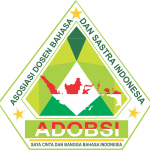HOW YOUTUBE INFLUENCES CHILDREN LANGUAGE ACQUISITIONS AND IMPACT THEIR ADVANCEMENT?: AN INVESTIGATION TO THE ELEMENTARY SCHOOL’S KIDS
Abstract
Keywords
Full Text:
PDFReferences
Auliyah, N. S., & Fadlilah, A. (2018). The impact of YouTube videos of children in English for toddler 2-4 years old. http://dx.doi.org/10.2139/ssrn.33057866
Braun, V., and Clarke, V. (2006). Using thematic analysis in psychology. Qualitative Research in Psychology, 3, 77-101. doi: 10.1191/1478088706qp063oa
Creswell, J. W. (2010). Research design. Yogyakarta: Pustaka Belajar.
Creswell, J. W. (2012). Educational research: Planning, conducting, and evaluating quantitative and qualitative research (4th ed.). Boston, MA: Pearson.
Davidson, C., Given, L. M., Danby, S., & Thorpe, K. (2014). Talk about a YouTube Video in Preschool: The Mutual Production of Shared Understanding for Learning with Digital Technology. Australasian Journal of Early Childhood, 39(3), 76–83. doi:10.1177/183693911403900310
Dewi, H. C. (2021). Language acquisition of english vocabulary on 5 years old child through social media youtube. HORTATORI, Jurnal Pendidikan Bahasa dan Sastra Indonesia, 5(1), 38-44. doi: https://doi.org/10.30998/jh.v5i1.588
Ferdiansyah, F., Supiastutik, Angin, R., (2020). Thai students' experiences of online learning at Indonesian universities in the time of COVID-19 pandemic. Journal of International Students, 10(S3), 58-74. doi: https://doi.org/10.32674/jis.v10iS3.3199
Gerbner, G., Gross, L., Morgan, M., Signorielli, N., & Shanahan, J. (2002). Growing up with television: Cultivation processes. In J. Bryant & D. Zillmann (Eds.), Media effects: Advances in theory and research (pp. 43–67). Lawrence Erlbaum Associates Publishers.
Gibson, K. (2020). Bridging the digital divide: Reflection on using WhatsApp instant messenger in youth research. Qualitative Research in Psychology. DOI: 10.1080/14780887.2020.1751902
Izci, B., Jones, I., Ozdemic, T., Alktebi, L., & Bakir, E. (2019). YouTube and young children: Research, concerns, and new direction. In book: Children, families, and technology in today’s society: What challanges? Which paths? (pp. 81-92). Portugal: Lisbon School of Education Publisher.
Maycut, P., & Morehouse, R. (1994). Beginning qualitative research: A philosophic and practical guide. London: Famlmer Press.
Neumann, M. M. (2015). Young children and screen time: Creating a mindful approach to digital technology. Australian educational computing, 30(2), 1-15. https://journal.acce.edu.au/index.php/AEC/article/view/67
Neumann, M. M., & Herodotou, C. (2020). Young Children and YouTube: A global phenomenon. Childhood Education, 96(4), 72–77. DOI: 10.1080/00094056.2020.1796459
Neumann, M. M., & Herodotou, C. (2020). Evaluating YouTube videos for young children. Education and Information Technologies, 1 – 17. DOI: 10.1007/s10639-020-10183-7
Rieger, D., & Christoph Klimmt. The daily dose of digital inspiration: A multi-method exploration of meaningful communication in social media. New Media & Society, 2018, 21(1), 97-118. DOI: https://doi.org/10.1177%2F1461444818788323
Ritcieh, W., & Bhatia, T. (1998). Handbook of child language acquisition. Netherlands: Brill Publishers.
Sahayu, W., & Friyanto. (2019). The effect of YouTube on high school students’ second language acquisition. International Journal of Linguistics, Literature and Translation (IJLLT). 2(6), 38-44. doi:10.32996/ijllt. 2019.2.6.5
Sari, Y. N., & Margana, M. (2019). YouTube as a Learning Media to Improve the Student’s Speaking Ability in 21st Century. Journal of English Language Teaching and Linguistics, 4(2), 263-278. doi: http://dx.doi.org/10.21462/jeltl.v4i2.296
Sauerland, M., Brackmann, N., and Otgaar, H. (2018). Rapport: Little effect on children’s, adolescents’, and adults’ statement quantity, accuracy, and suggestibility. Journal of Child Custody, 15(4), 268-285. https://doi.org/10.1080/15379418.2018.1509759
Sekerina, I. A., Fernandez, E. M., & H. Clahsen (eds). (2008). Developmental psycholinguistics. On-line methods in children’s language processing. Amsterdam : John Benjamins Publishing Company.
Supiani, Rafidiyah, D., Yansyah, & Nadia, H. (2020). The emotional experiences of Indonesian PhD students studying in Australia during the COVID-19 Pandemic. Journal of International Students, 10(S3), 108–125. doi: https://doi.org/10.32674/jis.v10iS3.3202
Widodo, H. P. (2014). Methodological considerations in interview data transcription. International Journal of Innovation in English Language Teaching and Research, 3(1), 101-107.
Wilkinson, D., & Birmingham, P. (2003). Using research instruments : A guide for researchers. USA, Canada : RoutledgeFalmer.
Refbacks
- There are currently no refbacks.






